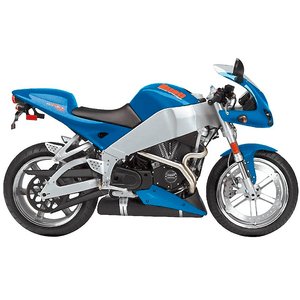Buell 900 Firebolt XB9 R [2002-2007]: A Quirky American Sportbike That Defies Convention
Introduction
The Buell XB9R Firebolt isn’t just a motorcycle—it’s a statement. Born from Erik Buell’s unorthodox engineering philosophy and Harley-Davidson’s powertrain legacy, this sport-oriented naked bike (or "streetfighter," depending on the model year) challenges the status quo of early 2000s motorcycling. With its mass-centralized design, thunderous V-twin character, and chassis innovations that still feel radical today, the Firebolt XB9R remains a cult classic. After spending time with a well-preserved 2005 example in Sunfire Yellow, here’s why this American oddball deserves your attention.
Design & Ergonomics: Form Follows Function (Mostly)
The Firebolt’s aesthetics split opinions. To some, it’s a futuristic masterpiece; to others, a collection of geometric experiments. The angular bodywork, underslung exhaust, and fuel-in-frame design scream "engineering first." The 14-liter (3.7 US gal) fuel tank is actually inside the aluminum frame spar—a innovation that lowers the center of gravity.
At 775 mm (30.5"), the seat height is accessible, but the riding position is pure sportbike: rearset pegs, low clip-ons, and a narrow seat that locks you into place. The Showa suspension components—43 mm inverted forks up front and a fully adjustable monoshock—hint at its performance intent.
Color options like Battle Blue and Racing Red pop even today, though the exposed frame welds and industrial finishes remind you this isn’t a polished Japanese machine. It’s raw, purposeful, and unapologetically American.
Engine & Performance: Torque Over Top-End
The 984cc air/oil-cooled V-twin—a derivative of Harley’s Sportster engine—delivers 92 HP (67 kW) at 7,500 RPM and 94.9 Nm (70 ft-lbs) of torque at 5,500 RPM. Numbers that underwhelm on paper but thrill in practice.
Throttle response is immediate. Below 4,000 RPM, it chugs like a cruiser; past 5,000 RPM, the Firebolt transforms. The V-twin’s vibrations intensify, but so does the acceleration—a primal push rather than a screaming rush. The 5-speed gearbox (a nod to Harley’s cruising roots) requires deliberate shifts, but the belt final drive is butter-smooth.
Fuel economy? Expect 4.1 L/100 km (57 mpg) if you’re gentle. Push hard, and the 14.5L (3.8 US gal) tank empties quickly. This isn’t a highway mile-eater; it’s a backroad bruiser that rewards aggressive riding.
Handling & Chassis: Where the Buell Shines
The Firebolt’s aluminum frame and 1,321 mm (52") wheelbase create a flickable, almost nervous agility. The ZTL (Zero Torsional Load) front brake—a single 240mm rotor gripped by a 6-piston caliper—delivers staggering stopping power. Initial bite is aggressive, requiring finesse in wet conditions.
Showa’s fully adjustable suspension soaks up bumps while maintaining razor-sharp feedback. The 120/70-ZR17 front and 180/55-ZR17 rear tires (still common sizes today) provide ample grip, though the short wheelbase can make the front end feel twitchy under hard acceleration.
At 175 kg (385 lbs) dry, it’s light enough for urban combat yet stable at speeds up to 210 km/h (130 mph). The Uniplanar engine mounts reduce vibration without dulling the mechanical connection between rider and machine.
Competition: Oddball vs. The Establishment
The XB9R’s closest rivals in 2002-2007 included:
-
Suzuki SV650S:
Lighter, cheaper, and revvier, the SV650S is the pragmatic choice. Its V-twin lacks the Buell’s low-end grunt but offers smoother high-RPM performance. Handling is more neutral, but it lacks the Buell’s theatrical flair. -
Ducati Monster S2R 800:
Italian style vs. American grit. The Ducati’s Desmo engine screams louder, but the Buell counters with better low-speed manners and innovative chassis tech. Maintenance costs favor the Buell—no desmo valve adjustments needed. -
Triumph Speed Triple 1050:
A British brute with 130 HP. The Triumph dominates straight-line speed, but its weight (198 kg / 436 lbs) dulls cornering precision. The Buell feels like a scalpel in comparison.
Verdict: The Firebolt XB9R isn’t the fastest or most refined, but its combination of torque, agility, and engineering audacity makes it unforgettable.
Maintenance: Keeping the Firebolt Alive
Owners praise the Buell’s reliability, but quirks demand attention:
-
Belt Drive:
The final drive belt lasts ~30,000 km (18,600 miles) but inspect it every 5,000 km (3,100 miles) for cracks. Upgrade to a high-performance belt from MOTOPARTS.store for improved durability. -
Oil Changes:
Use SAE 20W-50 synthetic. Capacity is 2.4L (2.5 US qt) with filter. The dry-sump system requires checking oil level via a dipstick near the rear cylinder. -
Valve Adjustments:
Hydraulic lifters eliminate manual adjustments—a rare low-maintenance win in this segment. -
Brake Upgrades:
Swap stock brake pads for sintered variants to reduce ZTL brake fade during spirited rides. -
Suspension Tuning:
Rebuild Showa units every 30,000 km (18,600 miles). Consider upgrading to progressive-rate springs for track use.
Pro Tip: The underslung exhaust can scrape on speed bumps. Install a MOTOPARTS.store axle slider kit to protect vulnerable components.
Conclusion: A Love Letter to the Nonconformist
The Buell Firebolt XB9R isn’t for everyone—and that’s the point. Its vibey engine, polarizing looks, and idiosyncratic engineering demand compromise. But for riders craving individuality, it delivers unmatched character. In an era of homogenized sportbikes, the Firebolt remains a rebellious wink from motorcycling’s golden age of experimentation.
Final Thought: This isn’t a motorcycle you buy; it’s one you adopt. Treat it well, embrace its quirks, and it’ll reward you with rides that no Japanese or European machine can replicate.



















